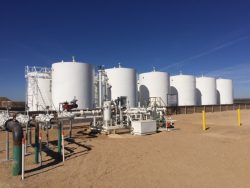Oil Tank Batteries: Everything You Need to Know about Design, Construction, and Maintenance
Oil Tank Batteries: Everything You Need to Know about Design, Construction, and Maintenance
Oil tank batteries are used to store crude oil, produced water, or natural gas liquids. They are a crucial part of the oil industry, providing a means of tracking the flow and storage of oil from production to transportation. A battery refers to a collection of multiple tanks, typically two or more, that are interconnected to form a single unit for the storage of hydrocarbons. In this blog post, we will discuss everything you need to know about oil tank battery design, construction, and maintenance.
Design of Oil Tank Batteries
The design of the oil tank batteries is critical for the efficient and safe storage of the hydrocarbons. There are several factors to consider in the design of oil tank batteries, including:
1. Volume of Oil to be Stored: The volume of oil to be stored is one of the most critical factors that determine the size of the tank battery. The amount of storage required will depend on the production rate, shipping schedules, and the number of wells connected to the tank battery.
2. Types of Oil and Liquids: The type of fluids stored in the oil tank is essential in the design of the tank battery. Different oils and liquids require different types of tanks, piping, and valves.
3. Location of the Tank Battery: The location of the tank battery is another critical factor that determines the design. The tank battery must be within the reach of pipelines and loading facilities for efficient transportation of the oil.
4. Weather Conditions: The weather conditions in the area are critical factors that determine the tank battery design. Special tanks are needed in areas with harsh weather conditions to withstand high winds and heavy snowfall.
Construction of Oil Tank Batteries
The construction of oil tank batteries is complex and requires specialized skills and knowledge. The process involves several steps that must be carefully followed to ensure a safe and efficient tank battery. Some of the significant steps in the construction of oil tank batteries include:
1. Site Preparation: Site preparation involves clearing and leveling the ground for the construction of the tank battery. This step involves removing trees, rocks, and other obstacles that could hinder construction.
2. Tank Foundation: The tank foundation is critical in the construction of the oil tank battery. The foundation must be solid and stable to support the weight of the tank and prevent soil erosion.
3. Tank Installation: Tank installation involves assembling the tank and placing it on the foundation. Before placing the tank on the foundation, the team must ensure that the foundation is level and stable.
4. Piping and Valves Installation: Piping and valve installation is the next critical step in the construction process. The piping and valves connect the tanks, allowing for the flow of hydrocarbons.
5. Electrical and Automation Systems Installation: The electrical and automation systems facilitate the control of the tank battery. These systems enable monitoring of the tank battery remotely and from a control room.
Maintenance of Oil Tank Batteries
The maintenance of oil tank batteries is critical to ensure their safe and efficient operation. Regular maintenance is necessary to extend the life of the tank battery, reduce downtime, and maintain optimal performance. Here are some critical maintenance practices for oil tank batteries:
1. Regular Inspection: Regular inspection of the tank battery is critical in identifying potential issues before they become problems. Inspections should be conducted daily, weekly, and monthly, depending on the size of the tanks and the volume of hydrocarbons stored.
2. Cleaning of the Tank: Tank cleaning is essential in maintaining the quality of the hydrocarbons stored. Accumulated sediment and sludge can clog the pipes and valves, leading to reduced flow rates and slower tank filling time.
3. Leak Detection and Repair: Leak detection is critical in maintaining the integrity of the tank battery. Leaks can cause environmental damage, fires, and significant losses.
4. Painting and Coating: Painting and coating of the tanks are essential in protecting the tanks from corrosion. Corrosion can reduce the life of the tank battery, leading to costly repairs and replacements.
Conclusion
Oil tank batteries are an essential part of the oil industry, providing a means of tracking the flow and storage of crude oil, produced water, or natural gas liquids. The design, construction, and maintenance of oil tank batteries are critical in ensuring their safe and efficient operation. The design of the tank battery must consider the volume of oil to be stored, location, weather conditions, and the type of fluids stored. Construction involves site preparation, tank foundation, tank installation, piping and valve installation, electrical and automation systems installation. Maintenance, on the other hand, involves regular inspection, tank cleaning, leak detection and repair, painting, and coating. By following these guidelines, oil tank batteries can provide the necessary storage for hydrocarbons while maintaining safe and efficient operations.
More...
Categorised in: Oil Tank Battery Installation




